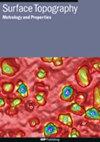Analysis of co-relation on LPBF process parameter on wear characteristics of Cu-Cr-Zr alloy
IF 2
3区 材料科学
Q2 ENGINEERING, MECHANICAL
引用次数: 0
Abstract
Copper alloy bearings, gears, and fasteners have a significant impact on industrial sectors. However, due to the defect formation and void generation during the manufacturing of copper alloy parts using (Laser Powder Bed Fusion) LPBF technique, the wear resistance of the copper alloy was significantly affected. Hence, the prime novelty of the current research is enhancing wear resistance by analyzing the interaction of combined LPBF parameters. In order to decrease cavity forms and reduce the wear rate of the printed Cu alloy components, the important LPBF process parameters such as Scan Velocity (SV) of 550, 750, and 950 mm s−1, Laser Power (LP) of 460, 540, and 620 W, and Re-melting Range (RR) of 5, 25, and 45% were selected and studied. The results of the experimental investigation were supported by the use of Grey Relation Analysis (GRA). A comparative study was conducted with five distinct parameter combinations to investigate the relative influence of each parameter on the relative density, wear rate and elastic modulus. The research findings verify that the application of optimal SV of 750 mm s−1 and RR of 45% with maximum LP of 460 W resulted in the maximum relative density of 99.91%, minimal wear rate of 0.52 × 10−5 mm3/Nm, and maximum elastic modulus of 140.22 GPa.LPBF 工艺参数对 Cu-Cr-Zr 合金磨损特性的相关性分析
铜合金轴承、齿轮和紧固件对工业领域有着重要影响。然而,在使用(激光粉末床熔融)LPBF 技术制造铜合金零件的过程中,由于缺陷的形成和空隙的产生,铜合金的耐磨性受到了严重影响。因此,本研究的主要创新点是通过分析 LPBF 组合参数的相互作用来提高耐磨性。为了减少印刷铜合金部件的空腔形状并降低磨损率,研究人员选择并研究了重要的 LPBF 工艺参数,如扫描速度(SV)为 550、750 和 950 mm s-1,激光功率(LP)为 460、540 和 620 W,再熔范围(RR)为 5、25 和 45%。实验调查的结果得到了灰色关系分析法(GRA)的支持。通过五种不同的参数组合进行了对比研究,以探究每种参数对相对密度、磨损率和弹性模量的相对影响。研究结果证实,采用最佳 SV 值 750 mm s-1 和 RR 值 45%,最大 LP 值 460 W 时,相对密度最大为 99.91%,磨损率最小为 0.52 × 10-5 mm3/Nm,弹性模量最大为 140.22 GPa。
本文章由计算机程序翻译,如有差异,请以英文原文为准。
求助全文
约1分钟内获得全文
求助全文
来源期刊

Surface Topography: Metrology and Properties
Materials Science-Materials Chemistry
CiteScore
4.10
自引率
22.20%
发文量
183
期刊介绍:
An international forum for academics, industrialists and engineers to publish the latest research in surface topography measurement and characterisation, instrumentation development and the properties of surfaces.
 求助内容:
求助内容: 应助结果提醒方式:
应助结果提醒方式:


